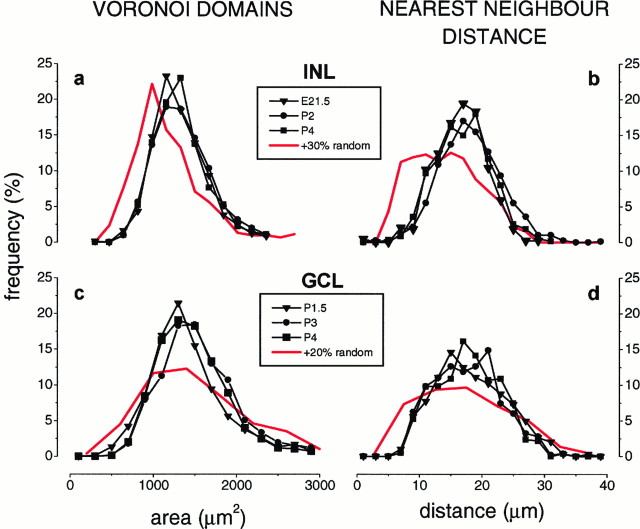Fig. 2.
Islet-1 mosaics preserve their spatial organization while new cells are added. a, Voronoi domains and (b) nearest neighbor distances of the INL mosaic on E21.5 (triangles), P2 (circles), and P4 (squares). No change with time is observed in the normalized histograms, although ∼30% more cells enter the mosaic between E21.5 and P4. When experimental variation is considered (not shown), the P4 distribution represents a fit for the E21.5 distribution, with p > 0.99 for the nearest neighbor distance and p > 0.95 for the Voronoi distribution, as determined by χ2 test.Red lines represent the distributions expected if the newly arrived cells were randomly added to the E21.5 mosaic. The difference between the P4 mosaic and the expected distribution in the case of random addition is statistically significant (χ2 test; p < 0.001). No change with time was also observed in the distribution of Delaunay segments (not shown). c, Normalized histograms of Voronoi domains and (d) nearest neighbor distances for the GCL mosaic of Islet-1+ cells. P1.5 (triangles), P3 (circles), and P4 (squares). Approximately 20% more cells are added to the Islet-1 mosaic of the GCL between P1.5 and P4 (24,000 ± 2000 on P1.5; 29,000 ± 1300 on P4), but the two distributions remain more regular than the expected distribution (red lines) if the 20% additional cells were randomly inserted in the GCL mosaic between P1.5 and P4. Although the mean of the distributions obtained for the random addition of cells (red lines) is the same as that for the real data in the case of Voronoi areas, the SD is larger, and the difference between the real and simulated distribution is statistically significant (p< 0.00001, as determined by χ2 analysis). Note that the two Islet-1 mosaics have the same minimal Voronoi area (compare a and c) and the same minimal intercellular spacing (compare b and d), although the regularity of the GCL mosaic is lower than that of the INL.

